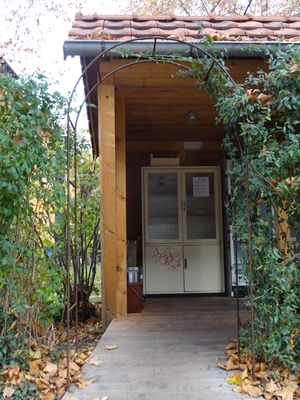Tackling Waste: Community Practices for Food Rescuing and Sharing
This scenario has been developed on the basis of a real world case.
Photo: A foodsharing dispensing location
Imagine your city where surplus-food is not being wasted and is instead rescued and shared among (poorer) communities.
How do we get there?
For this to happen, citizens could have the leading role, identifying pertinent social problems in the food sector such as food waste and food insecurity. While these issues are often regulated by governmental policies (e.g. food waste management and food safety), community-based actions could be undertaken by citizens to complement them (Q10).
How can such citizens' initiatives thrive?
Such interventions require social resources to develop. For example, relying on a wider-community network could be of great support. Indeed, networks provide social movements with resources (human and material) and legitimacy (in the public opinion and political sphere) (Q13). In addition, community-based initiatives likely have better chances of success while relying on an established organizational structure with well-defined distribution of roles and responsibilities among community members, in tandem with some operating tools (Q15).
What legal obstacles may food rescuers face? And how could they cope?
Such a project could be faced with particular regulatory framework in the food sector that poses an obstacle to operations (Q18). Eventually, a problem may arise when community initiatives are asked to comply with regulatory policies that they often do not have the capacity to meet i.e. food handling (Q23). Therefore, strict regulations primarily designed for larger food producers and distributors can hinder or even prevent citizens’ initiatives.
Eventually, facing these kinds of obstacles could reinforce opposition between the intervention proponents and governing bodies. A positive effect may be the strengthening of the political line of the movement (Q24) and its establishment as an oppositional power challenging (dysfunctional) governmental policy (Q21). However, legal pressures to comply with the pre-existing framework to some extent reduces the potential impact of such projects.
How can we learn from such an intervention?
The different processes featured here could be recorded and shared within community networks (Q29). This allows the movement to spread and develop, facilitated by the local bodies of wider community-networks (Q31). Additionally, activists could actively engage in sharing their knowledge and tools for facilitating the replication of the intervention in other urban contexts. Thus, similar initiatives would be likely to develop elsewhere, either by sticking to the organizational structure of the movement or by inventing different ways of operating (Q33).
How could this reality be created in your city? What obstacles would have to be overcome?
Do you want to learn more about this scenario?
Take a look at the detailed description of Citizens rescuing and sharing food in Berlin that has inspired this scenario. Foodsharing is a grassroots initiative that thrives to rescue and share surplus food among citizens. Its proponent consider food as a "common good" which has to be exempted from monetary transaction. Check out their website (only in German), https://foodsharing.de/
This scenario relates to some enabling governance arrangements:
- Tap into existing community networks - Foodsharing groups tapped into the resources of the national network to develop locally, especially they used the same online platform as well as the same principles and organizational structure.
- Develop resilient, and self-sufficient financing arrangements - Foodsharing is run by unpaid volunteers, including developers, foodshares and foodsavers and refuses any public funding or subsidies..
This scenario fits under the approach:
It addresses some drivers of injustice:
- Exclusive access to the benefits of sustainability infrastructure
- Unfit institutional structures
- Unquestioned Neoliberal growth and austerity urbanism
- Weak(ened) civil society
What do you think about this scenario? Was it helpful to you? Do you find our approach problematic? Send us an email to Philipp Spaeth.
